























The Holding Place
While balancing unpaid emotional and domestic labour with full-time paid work, Emma O’Brien placed her photographic practice on hold. It was an indulgence she couldn't afford, Motherhood demanded this sacrifice. As her child grew, influenced by Matricentric Feminism, working with a feminist concept of intersubjectivity, “how to care for another and one’s self”, she began carving the time to explore her role as mother and artist. Photographing her every day, including smart phone archival images, Emma celebrates mothering and calls out motherhood.
The Holding Place is a meditation on the physical, psychological and political landscape of Motherhood. The small world that is inhabited, the recurring daily routines, the scant time available, and the intimacy of the mother-child relationship all shape the work. Feminism has changed women's life outside the home, but little has changed inside the home. In her work the personal and political blur, she hints at her simmering rage and frustration borne by the imbalances of motherhood while also proclaiming her contradictory feelings of love and devotion. She aims to show the value of caring and nurturing while exposing the patriarchal capitalist structures that impose an experience of entrapment on mothers. The work reveals that while motherhood undoubtedly gives something, it also takes something valuable away.














































The Holding Place
While balancing unpaid emotional and domestic labour with full-time paid work, Emma O’Brien placed her photographic practice on hold. It was an indulgence she couldn't afford, Motherhood demanded this sacrifice. As her child grew, influenced by Matricentric Feminism, working with a feminist concept of intersubjectivity, “how to care for another and one’s self”, she began carving the time to explore her role as mother and artist. Photographing her every day, including smart phone archival images, Emma celebrates mothering and calls out motherhood.
The Holding Place is a meditation on the physical, psychological and political landscape of Motherhood. The small world that is inhabited, the recurring daily routines, the scant time available, and the intimacy of the mother-child relationship all shape the work. Feminism has changed women's life outside the home, but little has changed inside the home. In her work the personal and political blur, she hints at her simmering rage and frustration borne by the imbalances of motherhood while also proclaiming her contradictory feelings of love and devotion. She aims to show the value of caring and nurturing while exposing the patriarchal capitalist structures that impose an experience of entrapment on mothers. The work reveals that while motherhood undoubtedly gives something, it also takes something valuable away.